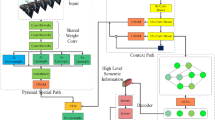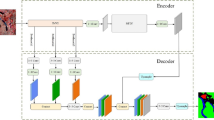Abstract
Remote sensing interpretation for surveillance of land use often needs to mark out construction disturbance on satellite imagery, such as illegal buildings or spoil area. These disturbance region annotated by a set of surveillance rules contain the corresponding image characteristics which are regarded as semantic information in computer vision. Different from the natural Landscapes interpretation, the semantic information of construciton disturbance region shows more complex to extract with lack of available training dataset and interference of the various sizes of targets. This paper proposes a hybrid attention semantic segmentation network (HAssNet) which can extract the target and its surroundings through a large receptive field for multi-scale targets. Based on the full convolutional networks (FCN), spatial attention mechanism is firstly introduced to acquire the position of segmentation target with the global correlations, so that the small targets in large scale scene are guaranteed not to be omitted in semantic features extraction. Secondly, channel attention mechanism is designed to assign higher weights to task-related channels for semantic consistency. Experimental results on an open remote sensing dataset show that HAssNet achieves average 6.7% improvement in mIoU than the state-of-the-art segmentation networks. In a land use surveillance project, HAssNet shows considerable performance compared with manual interpretation.








Similar content being viewed by others
References
Lillesand T, Kiefer RW, Chipman J (2015) Remote sensing and image interpretation. Wiley, Hoboken
Lv N, Chen C, Qiu T, Sangaiah AK (2018) Deep learning and superpixel feature extraction based on contractive autoencoder for change detection in sar images. IEEE Trans Industr Inf 14(12):5530–5538
Cong W, Chen C, Qingqi P, Zhiyuan J, Shugong X (2021) An information centric in-network caching scheme for 5g-enabled internet of connected vehicles. IEEE Trans Mob Comput. https://doi.org/10.1109/TMC.2021.3137219
Lin F, Wang J, Sun Yun (2016) Establishment of interpretation signs of disturbance patterns in production and construction projects based on high resolution remote sensing images. Soil Water Conserv China 11:16–20
Strahler AH (1980) The use of prior probabilities in maximum likelihood classification of remotely sensed data. Remote Sens Environ 10(2):135–163
Goldberg M, Shlien S (1978) A clustering scheme for multispectral images. IEEE Trans Syst Man Cybern 8(2):86–92
Xu Y, Xie Z, Feng Y, Chen Z (2018) Road extraction from high-resolution remote sensing imagery using deep learning. Remote Sens 10(9):1461
Yu K, Liu J, Lu Z (2017) An adaptive multi-threshold image segmentation algorithm based on object-oriented classification for high-resolution remote sensing images. In: AOPC 2017: Optical sensing and imaging technology and applications, international society for optics and photonics. vol 10462. p 104624B
Ali M, Clausi D (2001) Using the canny edge detector for feature extraction and enhancement of remote sensing images. In: IGARSS 2001. Scanning the present and resolving the future. Proceedings. IEEE 2001 international geoscience and remote sensing symposium (Cat. No.01CH37217), vol 5, pp 2298–2300. https://doi.org/10.1109/IGARSS.2001.977981
Ming D, Li J, Wang J, Zhang M (2015) Scale parameter selection by spatial statistics for Geobia: using mean-shift based multi-scale segmentation as an example. ISPRS J Photogramm Remote Sens 106:28–41
Zhang G, Jia X, Hu J (2015) Superpixel-based graphical model for remote sensing image mapping. IEEE Trans Geosci Remote Sens 53(11):5861–5871
Wang Y, Li D, Wang Y (2019) Realization of remote sensing image segmentation based on k-means clustering. In: IOP Conference Series: Materials Science and Engineering, IOP Publishing, vol 490, p 072008
Liu T, Wen XB, Quan JJ, Xu XQ (2008) Multiscale sar image segmentation using support vector machines. In: 2008 Congress on Image and Signal Processing, IEEE, vol 3, pp 706–709
Simonyan K, Zisserman A (2014) Very deep convolutional networks for large-scale image recognition. arXiv preprint arXiv:1409.1556
Long J, Shelhamer E, Darrell T (2015) Fully convolutional networks for semantic segmentation. In: Proceedings of the IEEE conference on computer vision and pattern recognition. pp 3431–3440
Badrinarayanan V, Kendall A, Cipolla R (2017) Segnet: a deep convolutional encoder-decoder architecture for image segmentation. IEEE Trans Pattern Anal Mach Intell 39(12):2481–2495
Ronneberger O, Fischer P, Brox T (2015) U-net: convolutional networks for biomedical image segmentation. In: International Conference on Medical image computing and computer-assisted intervention. Springer, pp 234–241
Zhao H, Shi J, Qi X, Wang X, Jia J (2017) Pyramid scene parsing network. In: Proceedings of the IEEE conference on computer vision and pattern recognitio. pp 2881–2890
Chen LC, Papandreou G, Schroff F, Adam H (2017) Rethinking atrous convolution for semantic image segmentation. arXiv preprint arXiv:1706.05587
Chen C, Liu L, Wan S, Hui X, Pei Q (2021) Data dissemination for industry 4.0 applications in internet of vehicles based on short-term traffic prediction. ACM Trans Internet Technol (TOIT) 22(1):1–18
Byeon W, Breuel TM, Raue F, Liwicki M (2015) Scene labeling with LSTM recurrent neural networks. In: Proceedings of the IEEE Conference on Computer Vision and Pattern Recognition. pp 3547–3555
Sukhbaatar S, Szlam A, Weston J, Fergus R (2015) End-to-end memory networks. arXiv preprint arXiv:1503.08895
Woo S, Park J, Lee JY, Kweon IS (2018) Cbam: convolutional block attention module. In: Proceedings of the European conference on computer vision (ECCV), pp 3–19
Tian C, Xu Y, Li Z, Zuo W, Fei L, Liu H (2020) Attention-guided CNN for image denoising. Neural Netw 124:117–129
Li J, Fan D, Yang L, Gu S, Lu G, Xu Y, Zhang D (2021) Layer-output guided complementary attention learning for image defocus blur detection. IEEE Trans Image Process 30:3748–3763. https://doi.org/10.1109/TIP.2021.3065171
Vaswani A, Shazeer N, Parmar N, Uszkoreit J, Jones L, Gomez AN, Kaiser Ł, Polosukhin I (2017) Attention is all you need. In: Advances in neural information processing systems. pp 5998–6008
Wang X, Girshick R, Gupta A, He K (2018) Non-local neural networks. In: Proceedings of the IEEE conference on computer vision and pattern recognition. pp 7794–7803
Cao Y, Xu J, Lin S, Wei F, Hu H (2019) Gcnet: non-local networks meet squeeze-excitation networks and beyond. In: Proceedings of the IEEE/CVF International Conference on Computer Vision (ICCV) Workshops
Fu J, Liu J, Tian H, Li Y, Bao Y, Fang Z, Lu H (2019) Dual attention network for scene segmentation. In: Proceedings of the IEEE/CVF Conference on Computer Vision and Pattern Recognition. pp 3146–3154
Li Y, Chen X, Zhu Z, Xie L, Huang G, Du D, Wang X (2019) Attention-guided unified network for panoptic segmentation. In: Proceedings of the IEEE/CVF Conference on Computer Vision and Pattern Recognition. pp 7026–7035
Hu J, Shen L, Sun G (2018) Squeeze-and-excitation networks. In: Proceedings of the IEEE conference on computer vision and pattern recognition. pp 7132–7141
Wang Q, Wu B, Zhu P, Li P, Zuo W, Hu Q (2020) Eca-net: efficient channel attention for deep convolutional neural networks, 2020 IEEE. In: CVF Conference on Computer Vision and Pattern Recognition (CVPR). IEEE
Wang X, Cai Z, Gao D, Vasconcelos N (2019) Towards universal object detection by domain attention. In: Proceedings of the IEEE/CVF Conference on Computer Vision and Pattern Recognition (CVPR)
Luo H, Chen C, Fang L, Zhu X, Lu L (2019) High-resolution aerial images semantic segmentation using deep fully convolutional network with channel attention mechanism. IEEE J Select Top Appl Earth Observ Remote Sens 12(9):3492–3507
He K, Zhang X, Ren S, Sun J (2016) Deep residual learning for image recognition. In: Proceedings of the IEEE conference on computer vision and pattern recognition. pp 770–778
Huang Z, Wang X, Huang L, Huang C, Wei Y, Liu W (2019) Ccnet: criss-cross attention for semantic segmentation. In: Proceedings of the IEEE/CVF International Conference on Computer Vision. pp 603–612
Zhong Z, Lin ZQ, Bidart R, Hu X, Daya IB, Li Z, Zheng WS, Li J, Wong A (2020) Squeeze-and-attention networks for semantic segmentation. In: Proceedings of the IEEE/CVF Conference on Computer Vision and Pattern Recognition. pp 13065–13074
Yuan Y, Huang L, Guo J, Zhang C, Chen X, Wang J (2018) Ocnet: object context network for scene parsing. arXiv preprint. arXiv:1809.00916
Zhu X, Cheng D, Zhang Z, Lin S, Dai J (2019) An empirical study of spatial attention mechanisms in deep networks. In: Proceedings of the IEEE/CVF International Conference on Computer Vision. pp 6688–6697
Chen C, Jiange J, Rufei F, Lanlan C, Cong L, Shaohua W (2021) An intelligent caching strategy considering time-space characteristics in vehicular named data networks. IEEE Trans Intell Transp Syst. https://doi.org/10.1109/TITS.2021.3128012
Niu R, Sun X, Tian Y, Diao W, Chen K, Fu K (2021) Hybrid multiple attention network for semantic segmentation in aerial images. IEEE Trans Geosci Remote Sens 2021(60):1–18
Acknowledgements
This work was supported by the National Key Research and Development Program of China (2019YFE0196600), the National Natural Science Foundation of China (62072360, 61902292, 62001357, 62072359, 62072355), the key research and development plan of Shaanxi province (2021ZDLGY02-09, 2019ZDLGY13-07, 2019ZDLGY13-04, 2020JQ-844), the key laboratory of embedded system and service computing (Tongji University) (ESSCKF2019-05), Ministry of Education, the Xi’an Science and Technology Plan (20RGZN0005) and the Xi’an Key Laboratory of Mobile Edge Computing and Security (201805052-ZD3CG36).
Author information
Authors and Affiliations
Corresponding author
Additional information
Publisher's Note
Springer Nature remains neutral with regard to jurisdictional claims in published maps and institutional affiliations.
Rights and permissions
About this article
Cite this article
Lv, N., Zhang, Z., Li, C. et al. A hybrid-attention semantic segmentation network for remote sensing interpretation in land-use surveillance. Int. J. Mach. Learn. & Cyber. 14, 395–406 (2023). https://doi.org/10.1007/s13042-022-01517-7
Received:
Accepted:
Published:
Issue Date:
DOI: https://doi.org/10.1007/s13042-022-01517-7




